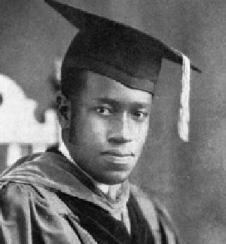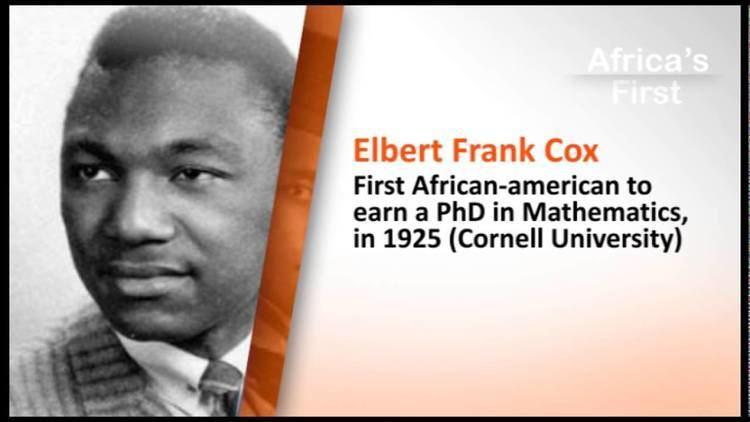Citizenship USA Nationality USA | Name Elbert Cox | |
 | ||
Doctoral advisor William Lloyd Garrison Williams Known for Generalised Euler polynomials, generalised Boole summation formula Died November 28, 1969, Washington, D.C., United States Academic advisor William Lloyd Garrison Williams | ||
Elbert frank cox video project
Elbert Frank Cox (December 5, 1895 – November 28, 1969) was an American mathematician who became the first black person in the world to receive a Ph.D. in mathematics. He spent most of his life as a professor at Howard University in Washington, D.C., where he was known as an excellent teacher. During his life, he overcame various difficulties which arose because of racism. In his honor, the National Association of Mathematicians established the Cox-Talbot Address, which is annually delivered at the NAM's national meetings. The Elbert F. Cox Scholarship Fund, which is used to help black students pursue studies, is named in his honor as well. In 1917 after graduating, Cox joined the U.S Army in World War I. After he discharged from the Army, he began his career as a high school math tutor.
Contents
- Elbert frank cox video project
- Elbert frank cox c cherry
- College years
- West Virginia State College
- Howard University
- Family
- Work
- References

Elbert frank cox c cherry
College years
Besides mathematics, Cox took courses in German, English, Latin, history, hygiene, chemistry, education, philosophy and physics. Cox's brother Avalon was at Indiana University as well; there were three other black students in his class. He received his bachelor's degree in 1917, at a time when the transcript of every black student had the word "COLORED" printed across it.

After serving in the US Army in France during World War I, he returned to pursue a career in teaching, as an instructor of mathematics at a high school in Henderson, Kentucky. In December 1921 he applied for admission to Cornell University, one of seven American universities with a doctoral program in mathematics. One of his references wrote a positive letter followed by another letter anticipating "... certain difficulties for the young man because of the fact he is of the colored race." Fox was awarded his PhD by Cornell in 1925, for his dissertation, The polynomial solutions of the difference equation af(x+1) + bf(x) = [Phi](x).
West Virginia State College

On September 16, 1925, Cox began teaching mathematics and physics at the then all-black, poorly funded West Virginia State College. Professors with a Ph.D. were a rarity there, and his international connections made him stand out as well. He received a salary of $1800. His influence can be seen in the large number of changes in the curriculum between 1925 and 1928. In 1927, he married Beulah Kaufman, the daughter of a former slave. She was a teacher at an elementary school, and worked with Cox' brother Avalon. He and Beulah had met in 1921 and had courted for six years. Their first child, James, was born in 1928. In 1929, he joined Howard University and moved to Washington, D.C..
Howard University
Cox started to teach at Howard University in September 1930. It was very different; despite his high credentials, he was outranked by other professors such as William Bauduit and Charles Syphax. Both had published multiple papers; it was only now that Cox published his graduation paper. Williams, his supervisor, tried to pursue recognition for Cox from a university in another country, but had difficulties in doing so. Different universities in England and Germany refused to consider his thesis, but the Tohoku Imperial University in Sendai, Japan did recognize it. It was published in the Tôhoku Mathematical Journal in 1934 [1]. It has been suggested that the refusal of his thesis by English and German universities was because of his race. Being an African American, it was difficult to get a job where he could focus on research rather than teaching. He was, however, very active in teaching: the university's president, James M. Nabrit, remarked that Cox had directed more Master's Degree students than any other professor at Howard's University. His students also performed better than those of other professors, and he was a popular professor. Among his students was his son Elbert Lucien Cox. Cox was promoted to professor in 1947. In 1954 he became head of the department of Mathematics, holding this position until 1961, when he had to quit because he had reached the age of 65. He continued teaching until his retirement in 1965 - three years before his death at age 73 in Washington. Although he did not live to see the first Ph.D. student graduate at Howard, many believe it was mainly due to his contributions that this became possible. Cox's portrait hangs in Howard University's common room.
Family
Elbert and Beulah Kaufman-Cox had four children: James born 1928, Eugene Kaufman born 1930, Elbert Lucien born 1933, and Kenneth, born 1935 but died at the age of 17 months.
Work
During his life, Cox published two articles. He expanded on the work Niels Nörlund had done on Euler polynomials as a solution to a particular difference equation[2]; in particular, Cox introduced generalised Euler polynomials and the generalised Boole summation formula as an expansion on the Boole summation formula. He also studied a number of specialised polynomials as solutions for certain differential equations. In his other paper, published in 1947, he mathematically compared three systems of grading.[3]
